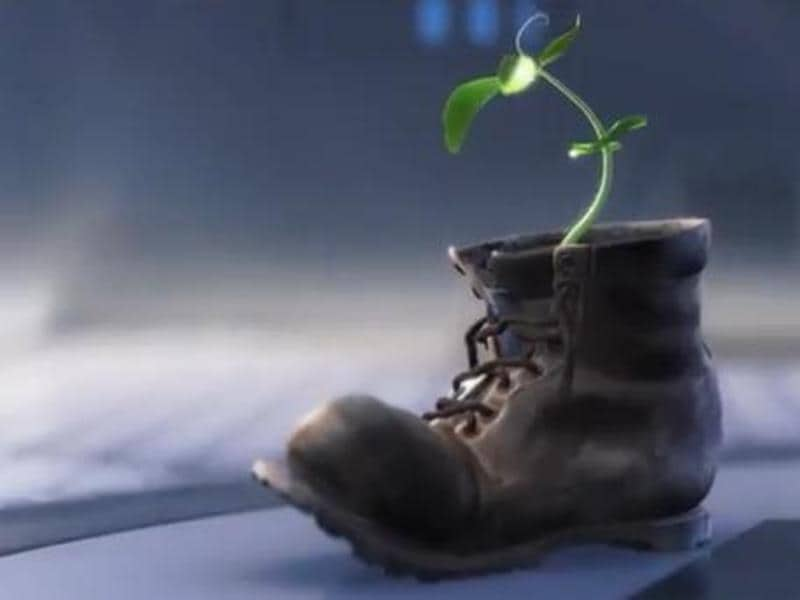Growing plants in space is tougher than you think it is
Growing plants in space is a lot tough than it would be on Mars. Because there’s no gravity

Mark Watney in The Martian had a tough time growing potatoes on Mars but so did the crew trying to grow space plants on Veggie — a vegetable production system being tested on the International Space Station (ISS) since May 2014. Now that the imperative movie reference is out of the way, you have to realise that growing plants in space is actually tougher than it would be on Mars. Because there's no gravity. Well, there is this faint gravitational pull astronauts call micro gravity, but it hardly helps.
Which is why it was a minor miracle when ISS astronaut, Scott Kelly posted a picture of a zinnia, the first flower grown in space, last week.
#MondayMotivation #SpaceFlower garden proving through challenge and continuous effort comes growth. #YearInSpace pic.twitter.com/wO1FpbWgCw
— Scott Kelly (@StationCDRKelly)
January 25, 2016
The first jab


Gravity is considered to be an important factor for the growth of roots. But somehow, the team at Veggie has managed to grow the zinnia flower and lettuce after a failed first attempt . This however, isn't the first time a seed has sprouted in space.
A NASA blog post details the agency's first attempts at growing a plant in outer space. Here's an excerpt:
"In August 2007, the STS-118 space shuttle mission launched into space, and with it launched 10 million cinnamon basil seeds. Nearly all of the seeds were returned to Earth for students to grow in plant growth chambers they designed, but 16 of the seeds were left behind on the International Space Station for an in-orbit experiment. Along with the seeds, two plant growth chambers, watering devices and drink bags were also left on the space station for Expedition 15 and 16 Flight Engineer Clayton Anderson to use to grow plants from the seeds. Anderson documented the plants' growth by photographing the plants inside the chambers every other day for nearly three weeks. The objective of the experiment was to demonstrate growing plants in a microgravity environment using small plastic chambers. Students can compare the results from their plant growth chamber experiments with Anderson's results."
Anderson documented the sapling's progress regularly and set the tone for gardening in space.


Why grow plants in space?
The answer is simple: to create a replenish-able supply of food for longer space travel, to possibly colonise other planets, and, you know, stay alive if you're stranded on Mars. For this to happen, the vegetables grown need to be palatable, nutritious and safe, for which the plant needs enough oxygen, carbon dioxide, humidity, light and temperature control, and gravity.


The Veggie satiates all the plant's nutritional and lighting needs but borrows the space station cabin's controlled environment (that the astronauts live in) for air and optimal temperature. If it's good enough for humans, it should be good enough for plants too.
So, do you just put the Veggie in a space station room that astronauts inhabit, turn it on, and farm away? No. It's space — nothing's that simple. The plants need more care, monitoring and environment-hacking that overcome the disadvantage of gravity's absence.
Growing plants in space also has some positive psychological benefits for astronauts. It is expected to become more important as space expeditions get longer.
John Glenn was the first US astronaut to eat in space. It wasn't as exciting as it sounds though. He had to squeeze out applesauce out of an aluminium tube into his mouth. It was a quick fix to the lack of proper dining conditions as transporting food and eating it without gravity would not just be messy but more workout than nutrition.
Tubes of borscht (beet soup) over which vodka labels have been pasted—https://t.co/e3XN9E5w6j (https://t.co/e3XN9E5w6j)> pic.twitter.com/8W17s5m6Uy
— Sanshey Biswas (@sanshey)
January 25, 2016
The current situation isn't as bad. Delicious food is cooked on earth and quickly frozen before being dehydrated and packed. In space, all a hungry astronaut has to do is squeeze hot water into the dehydrated food's packing. To beat the problem of gravitational scarcity, they strap a tray to their laps with the help of velcro. This method has allowed astronauts to enjoy food that they would normally have on Earth, even in space. From fruits, vegetables to drinks, everything is dehydrated for space consumption.
But then again, it's space, nothing's that simple. Some astronauts experience digestive problems after spending too much time in space. A combination of good bacteria and micro gravity is suspected to be the cause of these issues and researchers are yet to find a definitive answer.
Other problems:


Plants are living organism like animals. They need air, water, nutrients and sun to grow. And as NASA's recent attempts demonstrate, they can do without gravity pretty much like astronauts. But, as on Earth, they still succumb to infections. The leaves of the zinnia flower growing in space have caught mould as it can be seen in the pictures posted by Kelly.
Our plants aren't looking too good. Would be a problem on Mars. I'm going to have to channel my inner Mark Watney. https://t.co/m30bwCKA3w">pic.twitter.com/m30bwCKA3wpic.twitter.com/m30bwCKA3w (https://t.co/m30bwCKA3w); Scott Kelly (@StationCDRKelly) December 27, 2015
"While the plants haven't grown perfectly," said Dr. Gioia Massa NASA's science team lead, in a NASA blog post, NASA science team lead for Veggie, "I think we have gained a lot from this, and we are learning both more about plants and fluids and also how better to operate between ground and station. Regardless of final flowering outcome we will have gained a lot."


The first attempt to put Veggie into action also failed due to draught stress — insufficient water to reach the plant for growth.
The next one set of plant to be attempted and successfully grown was the lettuce that was cultivated and consumed within a month. And now, the zinnia flower — much more sensitive to its environment and takes longer to grow— is showing promising progress.
What to expect next from astro-farmers? Some tomato plants are the most likely successors to zinnia. But then again, it's space. Nothing is that simple.
Catch all the Latest Tech News, Mobile News, Laptop News, Gaming news, Wearables News , How To News, also keep up with us on Whatsapp channel,Twitter, Facebook, Google News, and Instagram. For our latest videos, subscribe to our YouTube channel.

























